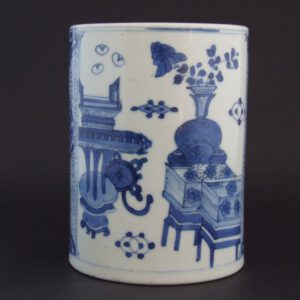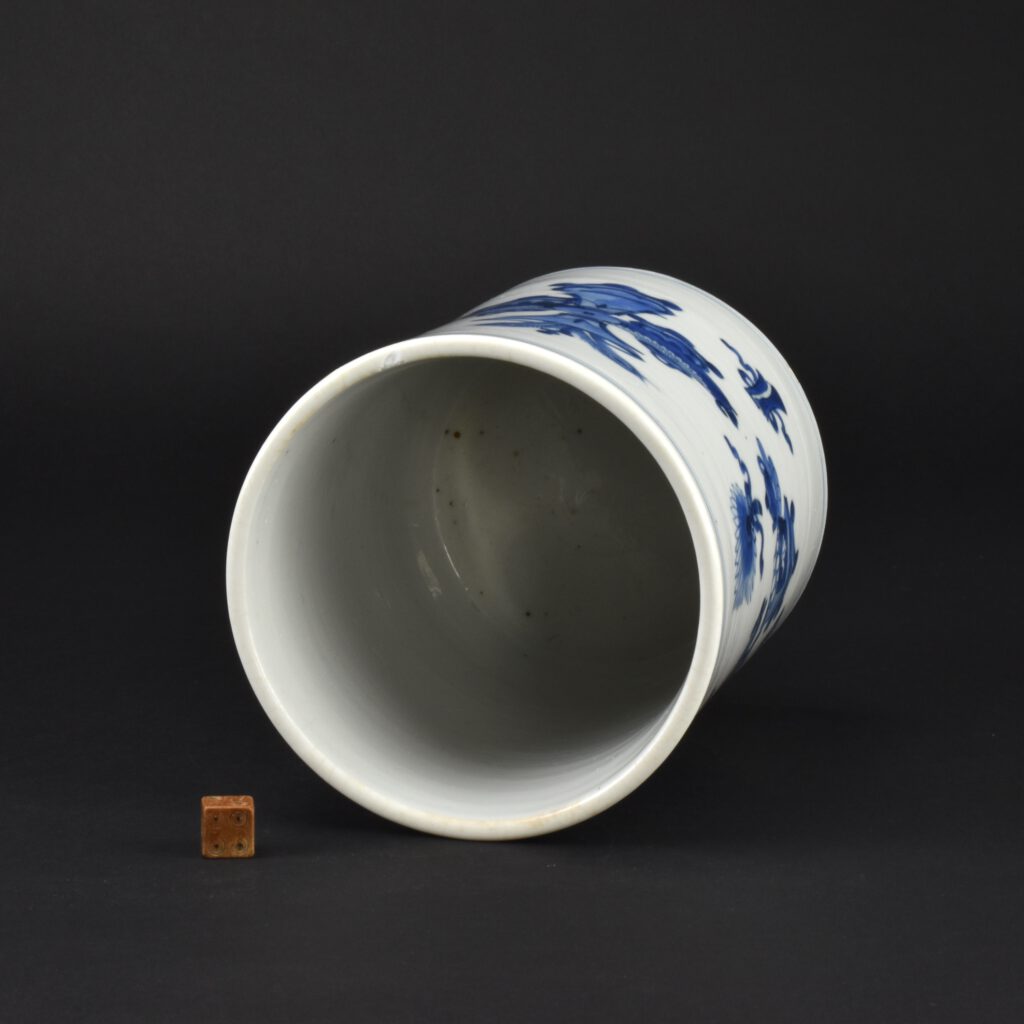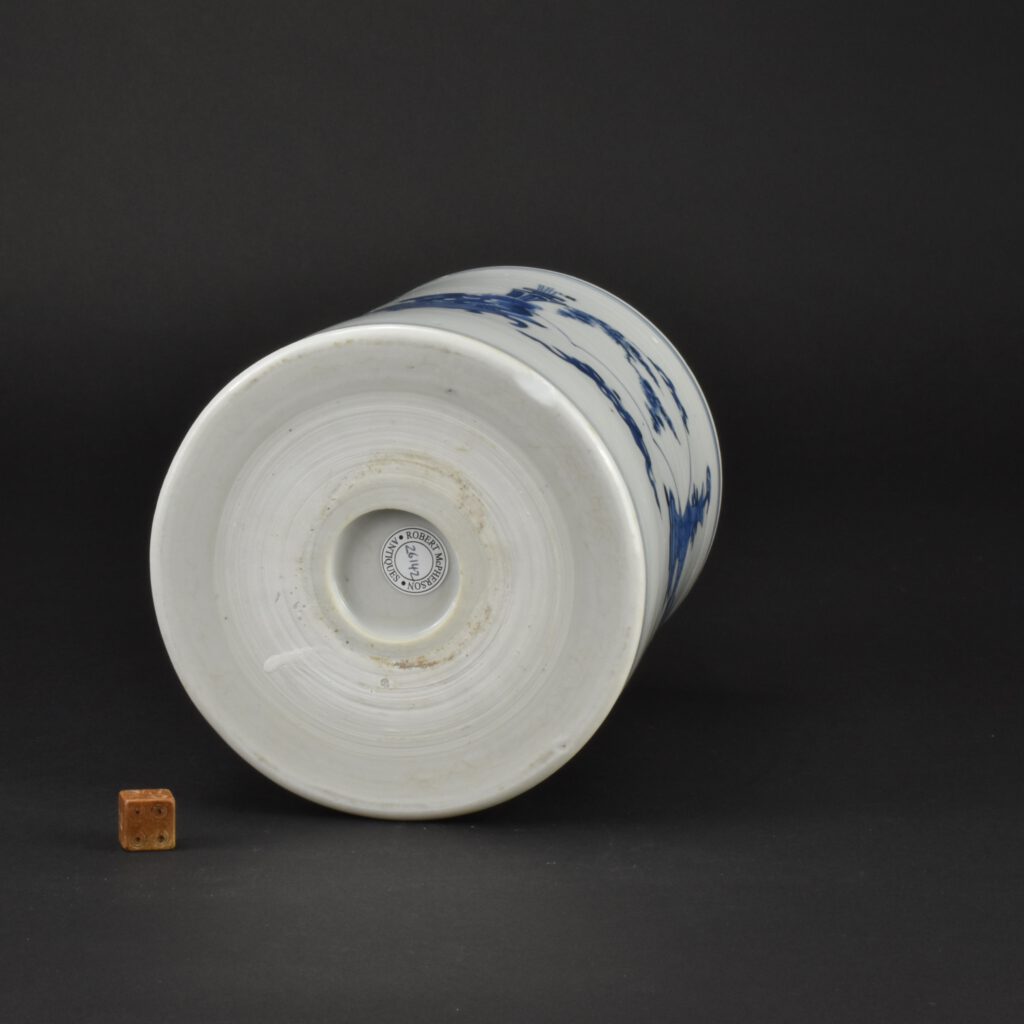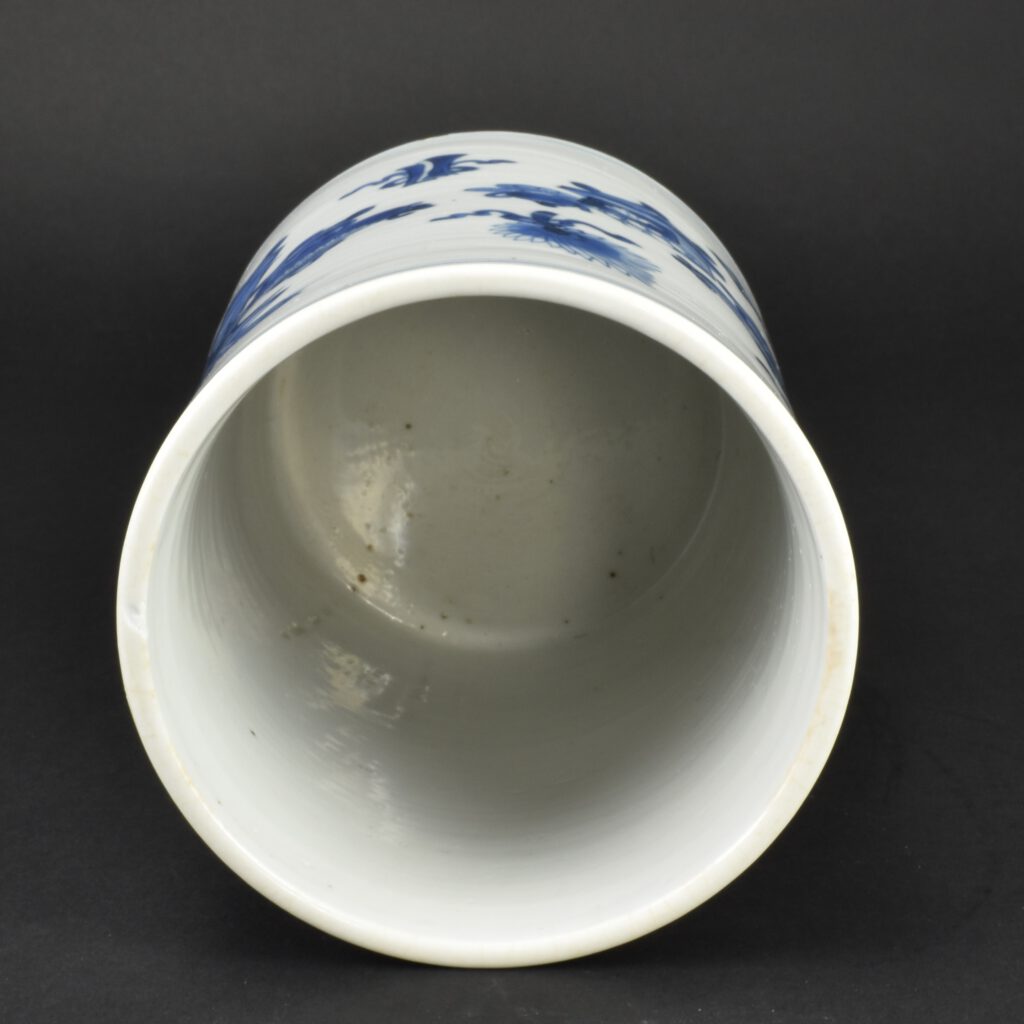
Kangxi Blue and White Porcelain Brushpot
A Kangxi Blue and White Porcelain Brushpot or Bitong c.1700. For more information about brushpots see below (under the photograph gallery). This heavily potted brushpot is decorated with various objects of significance in a design sometimes referred to as the ‘Hundred Antiques Pattern’. In fact it is not one pattern or design, more a range of designs showing precious objects, all of which have meaning, some of which are from the ‘Eight Precious Objects’ and a wider range of precious objects. The focal point of this Kangxi brushpot is a altar set, the type used in home shrines as well as temples and public buildings. This three piece altar set comprises of a Gu vase (an archaic bronze form) flanked by a pair of censers. The vase displays two peacock feathers and in the center a piece of coral. To the right is a leaf with a Cash (one of the Eight Precious objects, a gold coin, representing wealth). Above that is a waterpot with spoon on a stand and above that two ‘Precious Objects’ tied with ribbon. Moving on, are two scrolls next to a dog of Fu on a rectangular stand, above a vase with objects, then a fan shaped painting of prunus in flower (heralding the beginning of Spring), below is a mirror with ribbon, this is one of the Eight Precious Objects (representing conjugal happiness). A tall vase on a stand has what looks like a Ruyi sceptre in it, the body of the vase is decorated with the ‘cracked ice’ pattern. Then there is another cencer, the same as the pair, and stand, below two precious objects and above what might be a weapon. Then there are books on a stand, a teapot, above it a Precious Object, perhaps a palm leaf, tied with ribbon and finally three Precious objects tied with ribbon.
SOLD
- Condition
- In good condition, a small flake chip to the foot, a small glaze frit to the top rim (see photographs below).
- Size
- Height 15.7 cm (61/4 inches) Diameter 12 cm (4 3/4 inches)
- Provenance
- From an English private collection.
- Stock number
- 26142
- References
- For a related Kangxi or Yongzheng Brushpot c.1700-1730. Robert McPherson Antiques, see our 'Sold Archive' 23830.
Information
A Related Kangxi or Yongzheng Brushpot c.1700-1730.
Robert McPherson Antiques, Sold Archive 23830.
A Large Late Kangxi or Yongzheng Blue and White Porcelain Bitong (Brushpot). The Tall Sides are Decorated with Objects Found in a Scholar's Studio, Books, a Weiqi Board and Counter Boxes, an Flowering Orchid (symbol of scholarship), there are Also Precious Objects. This Design is Sometimes Referred to as `The Hundred Antiques Pattern`.
Condition : Very good, a tiny shallow glaze chip to the lower edge.
- Size Height : 16 cm (6 1/4 inches).
- Provenance : Anthony Garrod Collection, label to base. Another label "K`ang Hsi 1662-1722".

Brushpots / Bitong
Bitong or brushpots are not found in 17th or early 18th century European inventories unlike some other ceramic forms which fulfill a specific Chinese function. Blanc de chine `libation cups`, were for example, made for drinking wine in China but they were imported in large numbers to the West. There curious forms appealed to Western tastes and were used in European displays or converted with the addition of a gilt bronze handle to become a bonbon dishes. Brushpots on the other hand seem to have been made exclusively for the Chinese domestic market and perhaps also for Chinese scholars in South East Asia. Bitong are an essential part of literati`s desk equipment, what is often referred to as a scholars desk. Other scholarly items for the desk might include a brush-rest, inkstone (for grinding the dry ink) a water pot for the water to add to the inkstone, a brushwasher as well as a table screen. Like other scholar`s objects they were made in a diverse range of material from natural gnarled branches of trees, highly polished wood, jade, bamboo and porcelain to name but a few. Brush-rests were used for keeping the brush from making stains on the scholars' table, in between use while the scholar was working, while brushpots were used for storing the brushes when they were not being used. However, depictions of brushpots clearly show they formed a decorative purpose as well. They can be seen with brushes, feathers, coral as well as other objects.
The Eight Precious Objects
1 - Dragon pearl (warding off evil)
2 - 'Cash' - golden coin (wealth)
3 - Lozenge (victory)
4 - Mirror (marital bliss)
5 - Books (learning)
6 - Mirror (conjugal happiness)
7 - Pair of Rhinoceros Horns (Happiness)
8 - Artemisia leaf (symbolising good health and healing)














